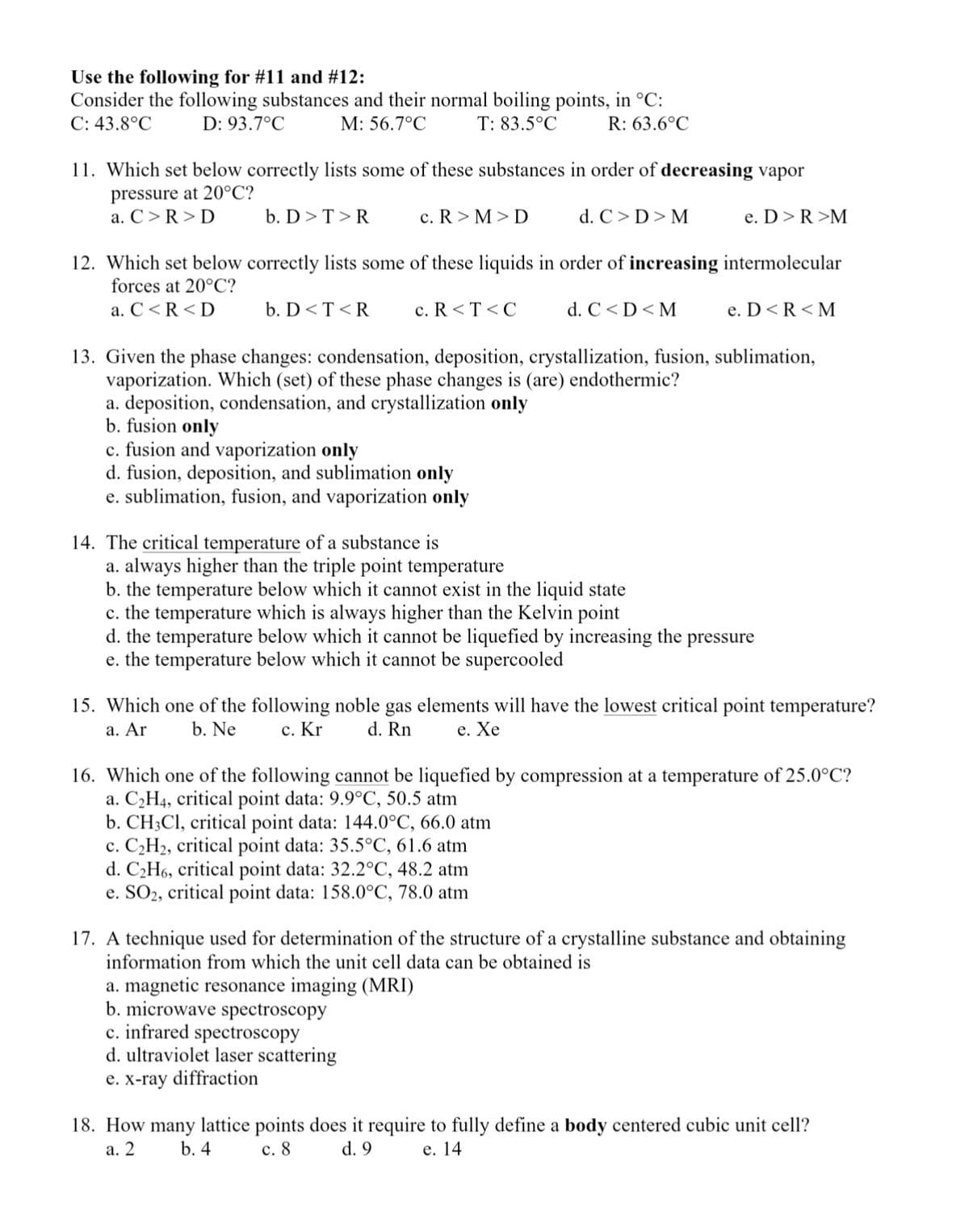Use the following for #11 and #12: Consider the following substances and their normal boiling points, in °C: C: 43.8°C D: 93.7°C M: 56.7°C T: 83.5°C R: 63.6°C 11. Which set below correctly lists some of these substances in order of decreasing vapor pressure at 20°C? a. C>R> D b. D>T>R c. R> M> D d. C> D> M e. D>R >M 12. Which set below correctly lists some of these liquids in order of increasing intermolecular forces at 20°C? a. C
Use the following for #11 and #12: Consider the following substances and their normal boiling points, in °C: C: 43.8°C D: 93.7°C M: 56.7°C T: 83.5°C R: 63.6°C 11. Which set below correctly lists some of these substances in order of decreasing vapor pressure at 20°C? a. C>R> D b. D>T>R c. R> M> D d. C> D> M e. D>R >M 12. Which set below correctly lists some of these liquids in order of increasing intermolecular forces at 20°C? a. C
Chapter10: Liquids And Solids
Section: Chapter Questions
Problem 108E: Consider the following data for xenon: Triple point: 121C, 280 torr Normal melting point: 112C...
Related questions
Question
I need help with 11 & 12 please and thank you.

Transcribed Image Text:Use the following for #11 and #12:
Consider the following substances and their normal boiling points, in °C:
C: 43.8°C
D: 93.7°C
M: 56.7°C
T: 83.5°C
R: 63.6°C
11. Which set below correctly lists some of these substances in order of decreasing vapor
pressure at 20°C?
a. C>R> D
b. D>T>R
c. R > M > D
d. C> D> M
e. D>R >M
12. Which set below correctly lists some of these liquids in order of increasing intermolecular
forces at 20°C?
a. C<R<D
b. D<T <R
c. R <T <C
d. C<D<M
e. D<R<M
13. Given the phase changes: condensation, deposition, crystallization, fusion, sublimation,
vaporization. Which (set) of these phase changes is (are) endothermic?
a. deposition, condensation, and crystallization only
b. fusion only
c. fusion and vaporization only
d. fusion, deposition, and sublimation only
e. sublimation, fusion, and vaporization only
14. The critical temperature of a substance is
a. always higher than the triple point temperature
b. the temperature below which it cannot exist in the liquid state
c. the temperature which is always higher than the Kelvin point
d. the temperature below which it cannot be liquefied by increasing the
e. the temperature below which it cannot be supercooled
pressure
15. Which one of the following noble gas elements will have the lowest critical point temperature?
a. Ar
b. Ne
с. Kr
d. Rn
е. Хе
16. Which one of the following cannot be liquefied by compression at a temperature of 25.0°C?
a. C2H4, critical point data: 9.9°C, 50.5 atm
b. CH3CI, critical point data: 144.0°C, 66.0 atm
c. C2H2, critical point data: 35.5°C, 61.6 atm
d. C2H6, critical point data: 32.2°C, 48.2 atm
e. SO2, critical point data: 158.0°C, 78.0 atm
17. A technique used for determination of the structure of a crystalline substance and obtaining
information from which the unit cell data can be obtained is
a. magnetic resonance imaging (MRI)
b. microwave spectroscopy
c. infrared spectroscopy
d. ultraviolet laser scattering
e. x-ray diffraction
18. How many lattice points does it require to fully define a body centered cubic unit cell?
а. 2
b. 4
с. 8
d. 9
е. 14
Expert Solution
This question has been solved!
Explore an expertly crafted, step-by-step solution for a thorough understanding of key concepts.
This is a popular solution!
Trending now
This is a popular solution!
Step by step
Solved in 3 steps with 3 images

Knowledge Booster
Learn more about
Need a deep-dive on the concept behind this application? Look no further. Learn more about this topic, chemistry and related others by exploring similar questions and additional content below.Recommended textbooks for you


Chemistry: An Atoms First Approach
Chemistry
ISBN:
9781305079243
Author:
Steven S. Zumdahl, Susan A. Zumdahl
Publisher:
Cengage Learning

Chemistry
Chemistry
ISBN:
9781305957404
Author:
Steven S. Zumdahl, Susan A. Zumdahl, Donald J. DeCoste
Publisher:
Cengage Learning


Chemistry: An Atoms First Approach
Chemistry
ISBN:
9781305079243
Author:
Steven S. Zumdahl, Susan A. Zumdahl
Publisher:
Cengage Learning

Chemistry
Chemistry
ISBN:
9781305957404
Author:
Steven S. Zumdahl, Susan A. Zumdahl, Donald J. DeCoste
Publisher:
Cengage Learning

Chemistry: Principles and Practice
Chemistry
ISBN:
9780534420123
Author:
Daniel L. Reger, Scott R. Goode, David W. Ball, Edward Mercer
Publisher:
Cengage Learning

Chemistry: Principles and Reactions
Chemistry
ISBN:
9781305079373
Author:
William L. Masterton, Cecile N. Hurley
Publisher:
Cengage Learning

Principles of Modern Chemistry
Chemistry
ISBN:
9781305079113
Author:
David W. Oxtoby, H. Pat Gillis, Laurie J. Butler
Publisher:
Cengage Learning